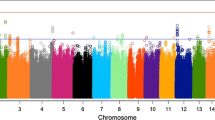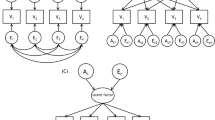Abstract
The influence of non-additive genetic influences on personality traits has been increasingly reported in adult populations. Less is known, however, with respect to younger samples. In this study, we examine additive and non-additive genetic contributions to the personality trait of extraversion in 1,689 Dutch twin pairs, 1,505 mothers and 1,637 fathers of the twins. The twins were on average 15.5 years (range 12–18 years). To increase statistical power to detect non-additive genetic influences, data on extraversion were also collected in parents and simultaneously analyzed. Genetic modeling procedures incorporating age as a potential modifier of heritability showed significant influences of additive (20–23%) and non-additive genetic factors (31–33%) in addition to unshared environment (46–48%) for adolescents and for their parents. The additive genetic component was slightly and positively related to age. No significant sex differences were found for either extraversion means or for the magnitude of the genetic and environmental influences. There was no evidence of non-random mating for extraversion in the parental generation. Results show that in addition to additive genetic influences, extraversion in adolescents is influenced by non-additive genetic factors.


Similar content being viewed by others
References
Agrawal A, Heath AC, Grant JD, Pergadia ML, Statham DJ, Bucholz KK, Martin NG, Madden PA (2006) Assortative mating for cigarette smoking and for alcohol consumption in female Australian twins and their spouses. Behav Genet 36:553–566
Ahern FM, Johnson RC, Wilson JR, McClearn GE, Vandenberg SG (1982) Family resemblances in personality. Behav Genet 12:261–280
Bergeman CSR, Plomin R, McClearn E, Pedersen NL, Friber LT (1988) Genotype-environment interaction in personality development. Psychol Aging 3:399–406
Boomsma D, Busjahn A, Peltonen L (2002a) Classical twin studies and beyond. Nat Rev Genet 3:872–882
Boomsma I, Beem AL, van den Berg M, Dolan CV, Koopmans JR, Vink JM, de Geus EJ, Slagboom PE (2000) Netherlands twin family study of anxious depression (NETSAD). Twin Res 3:323–334
Boomsma DI, Princen HM, Frants RR, Gevers Leuven JA, Kempen HJ (2003) Genetic analysis of indicators of cholesterol synthesis and absorption: lathosterol and phytosterols in Dutch twins and their parents. Twin Res 6:307–314
Boomsma DI, Vink JM, van Beijsterveldt TC, de Geus EJ, Beem AL, Mulder EJ, Derks EM, Riese H, Willemsen GA, Bartels M, van den Berg M, Kupper NH, Polderman TJ, Posthuma D, Rietveld MJ, Stubbe JH, Knol LI, Stroet T, van Baal GC (2002b) Netherlands Twin Register: a focus on longitudinal research. Twin Res 5:401–406
Buss AH, Plomin R (1984) Temperament: early developing personality traits. Erlbaum, Hillsdale, NJ
Cloninger CR, Przybeck TR, Svrakic DM, Wetzel RD (1994) The temperament and character inventory (TCI): a guide to its development and use. Center for Psychobiology of Personality, Washington University, St. Louis, MO
Costa PT, McCrae RR (1992) Revised NEO personality inventory and NEO five-factor inventory: professional manual. Psychological Assessment Resources, Inc, Odessa, FL
Costa PT, Terracciano A, McCrae RR (2001) Gender differences in personality traits across cultures: robust and surprising findings. J Pers Soc Psychol 81:322–331
Coventry WL, Keller MC (2005) Estimating the extent of parameter bias in the classical twin design: A comparison of parameter estimates from extended twin-family and classical twin designs. Twin Res Hum Genet 8:214–223
DiLalla LF, Jones S (2000) Genetic and environmental influences on temperament in preschoolers. In: Molfese VJ, Molfese DL (eds) Temperament and personality development across the life span. Lawrence Erlbaum Associates, Mahway, NJ, pp 33–55
Eaves LJ (1972) Computer simulation of sample size and experimental design in human psychogenetics. Psychol Bull 77:144–152
Eaves LJ (1988) Dominance alone is not enough. Behav Genet 18:27–33
Eaves L, Heath A, Martin N, Maes H, Neale M, Kendler K, Kirk K, Corey L (1999) Comparing the biological and cultural inheritance of personality and social attitudes in the Virginia 30,000 study of twins and their relatives. Twin Res 2:62–80
Eaves LJ, Heath AC, Neale MC, Hewitt JK, Martin NG (1998) Sex differences and non-additivity in the effects of genes on personality. Twin Res 1:131–137
Eysenck HJ, Eysenck SBG (1975) Manual for the Eysenck personality inventory (adult and junior). Digits, San Diego, CA
Gillespie NA, Evans DE, Wright MM, Martin NG (2004) Genetic simplex modeling of Eysenck’s dimensions of personality in a sample of young Australian twins. Twin Res 7:637–648
Gjone H, Stevenson J (1997) A longitudinal twin study of temperament and behavior problems: common genetic or environmental influences? J Am Acad Child Adolesc Psychiatry 36:1448–1456
Heath AC, Neale MC, Kessler RC, Eaves LJ, Kendler KS (1992) Evidence for genetic influences on personality from self-report and informant ratings. J Pers Soc Psychol 63:85–96
Hur YM (2007) Evidence for nonadditive genetic effects on Eysenck Personality Scales in South Korean twins. Twin Res Hum Genet 10:373–378
Hur YM (2006) Nonadditive genetic effects on hostility in South Korean adolescent and young adult twins. Twin Res Hum Genet 9:637–641
Johnson AM, Vernon PA, Harris JA, Jang KL (2004) A behavior genetic investigation of the relationship between leadership and personality. Twin Res 7:27–32
Keller MC, Coventry WL (2005) Quantifying and addressing parameter indeterminancy in the classical twin design. Twin Res Hum Genet 8:201–213
Keller MC, Coventry WL, Heath AC, Martin NG (2005) Widespread evidence for non-additive genetic variation in Cloninger’s and Eysenck’s personality dimensions using a twin plus sibling design. Behav Genet 35:707–721
Koopmans JR, Boomsma DI (1996) Familial resemblances in alcohol use: genetic or cultural transmission? J Stud Alcohol 57:19–28
Loehlin JC (1992) Genes and environment in personality development. Sage, Newbury Park, CA
Loehlin JC, Willerman L, Horn JM (1985) Personality resemblances in adoptive families when the children are late-adolescent or adult. J Pers Soc Psychol 48:376–392
Martin NG, Eaves LJ, Kearsey MJ, Davies P (1978) Power of classical twin study. Heredity 40:97–116
Mather K (1974) Non-allelic interaction in continuous variation of randomly breeding populations. Heredity 32:414–419
McCrae RR (1991) The counterpoint of personality assessment: self-reports and ratings. Paper presented at the meeting of the American Psychological Association, San Francisco
McCrae RR, Costa PT, Ostendorf F, Angleitner A, Hrebickova M, Avia MD, Sanz J, Sanchez-Bernardos ML, Kusdil ME, Woodfield R, Saunders PR, Smith PB (2000) Nature over nurture: temperament, personality, and life span development. J Pers Soc Psychol 78:173–186
McGue M, Bacon S, Lykken DT (1993) Personality stability and change in early adulthood: a behavioral genetic approach. Dev Psychol 29:96–109
Neale MC, Boker SM, Xie G, Maes HH (2004) Mx: statistical modeling. Department of Psychiatry, Richmond, VA
Plomin R, DeFries JC, MCClearn GE, McGuffin P (2001) Behavior genetics. Worth Publishers, New York
Posthuma D, Boomsma DI (2000) A note on the statistical power in extended twin designs. Behav Genet 30:147–158
Purcell S (2002) Variance components models for gene-environment interaction in twin analysis. Twin Res 5:554–571
Rebollo I, Boomsma DI (2006a) Genetic analysis of anger: genetic dominance or competitive sibling interaction. Behav Genet 36:216–228
Rebollo I, Boomsma DI (2006b) Genetic and environmental influences on type A behavior pattern: evidence from twins and their parents in the Netherlands Twin Register. Psychosom Med 68:437–442
Reiss D, Neiderhiser JM, Hetheringon EM, Plomin R (2000) The relationship code: deciphering genetic and social influences on adolescent development. Harvard University Press, Cambridge, MA
Rettew DC, Vink J, Willemsen G, Doyle A, Hudziak JJ, Boomsma DI (2006) The genetic architecture of neuroticism in 3301 Dutch adolescent twins as a function of age and sex: a study from the Dutch Twin Register. Twin Res Hum Genet 9:24–29
Riemann R, Angleitner A, Strelau J (1997) Genetic and environmental influences on personality: a study of twin reared together using the self- and peer report NEO-FFI scales. J Person 65:449–476
Rietveld MJ, Hudziak JJ, Bartels M, Van Beijsterveldt CE, Boomsma DI (2003) Heritability of attention problems in children: I. cross-sectional results from a study of twins, age 3–12 years Am J Med Genet 117B:102–113
Rietveld MJ, van Der Valk JC, Bongers IL, Stroet TM, Slagboom PE, Boomsma DI (2000) Zygosity diagnosis in young twins by parental report. Twin Res 3:134–141
Rothbart MK, Ahadi SA, Hershey K, Fisher P (2001) Investigations of temperament at 3–7 years: the children’s behavior questionnaire. Child Dev 72:1394–1408
Saudino KJ, Cherny SS (2001) Sources of continuity and change in observed temperament. In: Emde RN, Hewitt JK (eds) Infancy to early childhood: genetic and environmental influences on developmental change. Oxford University Press, New York, pp 89–110
Schermelleh-Engle K, Moosbrugger H, Muller H (2003), Evaluating the fit of structural equation models: tests of significance and descriptive goodness of fit measures. Meth Psychol Res Online 8:23–74
Tellegen A (1985) Structures of mood and personality and their relevance to assessing anxiety, with an emphasis on self-report. In: Tuma AH, Maser JD (eds) Anxiety and the anxiety disorders. Erlbaum, Hillsdale, NJ, pp 681–706
Van Leeuwen M, van den Berg SM, Boomsma DI (in press) A twin-family study of general IQ. Learn Indiv Diff
Viken RJ, Rose RJ, Kaprio J, Kosenvuo M (1994) A developmental genetic analysis of adult personality: extraversion and neuroticism from 18 to 59 years of age. J Pers Soc Psychol 66:722–730
Wilde GJS (1970) Neurotische labiliteit gemeten volgens de vragenlijstmethode (The questionnaire method as a means of measuring neurotic instability). Van Rossen, Amsterdam
Willemsen G, Posthuma D, Boomsma DI (2005) Environmental factors determine where the Dutch live: results from the Netherlands twin register. Twin Res Hum Genet 8:312–317
Zuckerman M (1979) Sensation seeking: beyond the optimal level of arousal. Lawrence Erlbaum Associates, Hillsdale, NJ
Acknowledgements
This work was supported by the Netherlands Organization for Scientific Research (NWO 985-10-002, NWO 900-562-137, and NWO-MagW 480-04-004), Spinozapremie NWO/SPI 56-464-14192, and by grants K08 MH069562, MH58799 and MH52813 from the National Institute of Mental Health, Rockville, Maryland, USA.
Author information
Authors and Affiliations
Corresponding author
Additional information
Edited by Stacey Cherny.
David C. Rettew and Irene Rebollo-Mesa contributed equally to this manuscript and should both be considered first-author.
Rights and permissions
About this article
Cite this article
Rettew, D.C., Rebollo-Mesa, I., Hudziak, J.J. et al. Non-additive and Additive Genetic Effects on Extraversion in 3314 Dutch Adolescent Twins and Their Parents . Behav Genet 38, 223–233 (2008). https://doi.org/10.1007/s10519-008-9192-5
Received:
Accepted:
Published:
Issue Date:
DOI: https://doi.org/10.1007/s10519-008-9192-5




